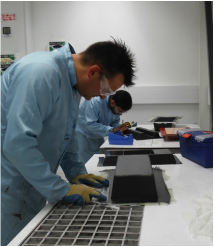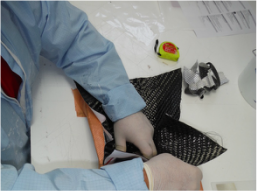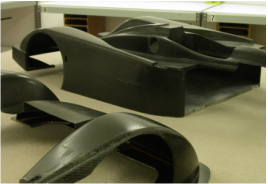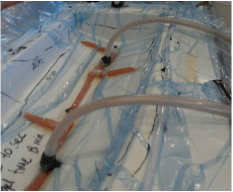|
Typical Attendees
This course is suitable for enthusiasts, start up and small companies who want to make their own composite parts and are unsure where to start. Our Aim We will show you how to set up a workshop where you can apply best practices on a budget. We will tell you what to buy and not buy and will recommend best value suppliers. As independent experts, we will get you the most cost effective solutions in terms of part quality, materials and equipment and save you money on expensive mistakes, we have no intention of selling you expensive materials or inadequate equipment. Structure 25% theory, 75% practical, 8 delegates maximum, no experience required Price per Delegate
£ 2,040.00 (£ 1700.00 plus £340.00 VAT) |
|
Producing your own composite parts course content
| DMSC60 | Session 1 09:00 - 11:00 |
Session 2 11:15 - 13:15 |
Session 3 13:45 - 15:45 |
Session 4 16:00 - 18:00 |
|---|---|---|---|---|
| Monday | Introduction Equipment issue Health & Safety Theory Introduction to composites theory, materials & processes |
Theory & Demos Tooling and component design principles Pattern making & materials Mould making & materials Laminate features |
Demo & Practical Production of a pattern using tooling board, including shaping, filling, surfacing, blocking up & final surface finishing using a range of bench tools and hand tools |
|
| Tuesday | Theory, Demo & Practical Pattern preparation & release agents Surface seal & release patterns |
Theory & Demos Wet lay-up laminating Wet lay-up calculations Material storage, dispensing, preparation & application Fume & exotherm control |
Practical Wet lay-up laminating of a mould including material preparation, dispensing, gel coating, wetting out & consolidation of glass fibre chopped strand mat, brush & roller application methods |
|
| Wednesday | Theory, Demo & Practical Resin infusion laminating Trial panels & evaluation Designing infusion layout for parts Resin calculations |
Practical Laminating a part for resin flow infused part including gel coating, application of cosmetic carbon fabric & structural glass fabric, application of distribution & infusion media |
Theory, Demo & Practical Vacuum bagging & materials Surface bagging of infusion parts Leak detection Practical Resin infusion of parts |
Demo & Practical Break out wet lay-up moulds Theory, Demo & Practical Trimming & finishing composites Trim & post-cure wet lay-up moulds |
| Thursday | Practical Surface finish & release wet lay-up moulds for use Theory Pre-preg laminating |
Theory, Demo & Practical Pre-preg life, storing, defrosting, templating, ply orientation, nesting & kitting |
Demo & Practical Pre-preg application & laminating of first skins cosmetic skins of a carbon fibre part |
Theory, Demo & Practical Sandwich structures Core materials Core preparation |
| Friday | Practical Laminate structural core & closing skins of a pre-preg part Demo & Practical Envelope vacuum bagging of pre-preg part |
Theory & Practical Curing pre-preg parts Basic ovens Practical Trim & finish composite parts produced |
Practical & Discussion Inspection of parts & identifying defects Theory & Discussion Delegate case studies & guidance |
Reinstate Workshop Written test Equipment return Summary / Feedback |
| DMSC60 Producing Your Own Composite Parts.pdf | |
| File Size: | 175 kb |
| File Type: | |
|
On this course you will learn how to produce composite parts from a sketch through to a pattern, mould and component using a range of cost effective methods and materials to achieve good results. It includes how to set up a basic workshop environment for the processes and cost effective investment.
We recommend this course for enthusiasts, start up and small companies who want to make their own composites. Delegates who have previously attended this course have gone on to set up their own production/companies knowing how to apply best practices on a budget. Throughout the week we will cover approximately 30 hours of practical. We begin by explaining the design principles for producing your own composite components. The approach is logical and a will take you through the stages of producing your own composite parts in a structured way. |
You will start by producing a pattern, following a component drawing. You will make your mould and produce your own components.
At each step in the process a new production method is introduced. The mould is made using wet lay-up laminating and the components made using both resin infusion and pre-preg laminating. Each new processing method is accompanied with technical demonstrations and theory to highlight the advantages and considerations when working with any of the processing methods.
When wet lay-up laminating, you will complete the required wet lay-up calculations, producing your composite mould using various laminating tools including brushes and rollers. Throughout the week you will learn the importance of composite material handling and storage, resin dispensing and accurate application.
As the resin flow infusion method can be difficult to predict you will first produce trial panels. These will provide the relevant information required to produce an infusion strategy for your component. You will lay up your parts applying the infusion media, surface vacuum bag, infuse the parts and cure at room temperature.
The final component is produced with pre-preg laminating. Composite sandwich structures are covered at this stage, looking at the advantages, preparation and identification of core materials. You will lay-up your part and envelope vacuum bag it before curing in the autoclave.
We then end the course with inspection of the parts and identifying defects. A group discussion will look at what causes defects and possible solutions.
We will look at which process and material works best in which application, cost implications and quality of part versus cost implication. Throughout the course we will be addressing materials and composite equipment suppliers.











